


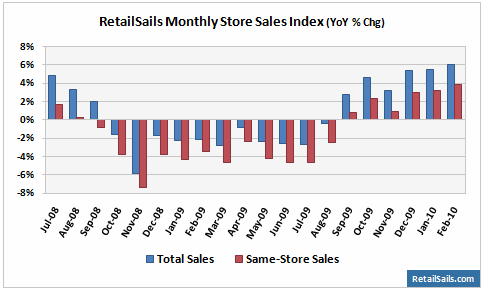



Nonfarm payroll employment was little changed (-36,000) in February, and theunemployment rate held at 9.7 percent, the U.S. Bureau of Labor Statisticsreported today. Employment fell in construction and information, while temporary help services added jobs. Severe winter weather in parts of the country may have affected payroll employment and hours; however, it is not possible to quantify precisely the net impact of the winter storms on the measures. For more information on the effects of the severe weather on employment estimates, see the box note at the end of the release.





Are the SPYs moving into an A/B/C (up/down/up) pattern? Let's take a look.


Reports from the twelve Federal Reserve Districts indicated that economic conditions continued to expand since the last report, although severe snowstorms in early February held back activity in several Districts. Nine Districts reported that economic activity improved, but in most cases the increases were modest. Overall conditions were described as mixed in the Atlanta and St. Louis Districts, though St. Louis noted further signs of improvement in some areas. Richmond reported that economic activity slackened or remained soft across most sectors, due importantly to especially severe February weather in that region.
Consumer spending showed signs of improvement in many Districts since the last report but was hampered in several regions by severe weather conditions in early February. Retail sales improved in the Chicago, Minneapolis, Dallas, and San Francisco Districts, and New York said sales were well above year-ago levels in January and met expectations in February despite inclement weather. Philadelphia also reported that sales were moving up slowly until snowstorms hit in February. Boston and Cleveland characterized sales as mixed but slightly higher overall than year ago levels. Sales were lower than expected in the Atlanta and Kansas City Districts and were down from year-ago levels in the St. Louis District. Several Districts reported that sales were strongest for lower-priced items, while sales of luxury and big ticket items remained sluggish. However, San Francisco noted scattered reports of increased discretionary spending, and Cleveland said some retailers noted a broader, if still slight, increase in demand across a variety of products. Inventories were being managed carefully and held at fairly low levels in most Districts, but Chicago said rising sales were leading retailers to begin rebuilding inventories from low levels.
Nonfinancial services activity was reported as steady or improved by the majority of Districts. Boston, St. Louis, Minneapolis, and San Francisco reported generally solid demand in health-care services, although Minneapolis noted continued weakness in elective procedures. New York indicated that a growing number of service firms planned to increase capital spending in the months ahead, but investment expectations diminished among high-tech companies in the Kansas City District. Richmond reported that service revenues fell due to the record snowstorms, but a few contacts saw a slight pickup in demand, particularly architectural firms, hospitals, and financial service professionals.
"The NMI (Non-Manufacturing Index) registered 53 percent in February, 2.5 percentage points higher than the seasonally adjusted 50.5 percent registered in January, indicating growth in the non-manufacturing sector. The Non-Manufacturing Business Activity Index increased 2.6 percentage points to 54.8 percent, reflecting growth for the third consecutive month. The New Orders Index increased 0.3 percentage point to 55 percent, and the Employment Index increased 4 percentage points to 48.6 percent. The Prices Index decreased 0.8 percentage point to 60.4 percent in February, indicating an increase in prices paid from January. According to the NMI, nine non-manufacturing industries reported growth in February. Respondents' comments vary by industry and company about business conditions."

Manufacturing activity increased further in most Districts, although Minneapolis, Dallas, and San Francisco characterized overall activity as flat or mixed. Philadelphia reported widespread production increases across most industries, and manufacturers in the Cleveland District reported a general rise in capacity utilization. Many Districts reported strong production in metals, and the Boston, Dallas, and San Francisco Districts noted strength in high-tech equipment, particularly semiconductors. Cleveland, Chicago, St. Louis, and Dallas noted solid improvements in auto-related manufacturing. A consumer goods company in the Boston District said European sales were at healthier levels. Contacts in the Chicago District reported strong growth in Asian exports but remained concerned about China's underlying economic strength. Dallas reported that exports for natural-gas based products remained strong, but weak demand for refined products has trimmed margins and cut capacity utilization further. Construction-related activity remained weak in the Chicago and Dallas Districts, and new orders for commercial aircraft and parts were sluggish in the San Francisco District. Philadelphia and Richmond noted productions delays due to the winter snowstorms in February, but some factories were able to make up the losses with longer work hours and extended shifts. Several manufacturers in the Philadelphia District said production gains could be limited due to continued tightening in credit markets and adverse developments in taxes and regulations. Plant managers in a few Districts reported that a large number of customers were simply restocking inventories, leading to concerns about the sustainability of the increase. However, contacts in most Districts remained optimistic for future months, with several reports of planned increases in capital spending.
Residential real estate markets improved in a number of Districts, remained weak or softened further in the New York, Atlanta, and Chicago Districts, was little changed in the San Francisco District, and characterized as mixed in the St. Louis District. Richmond also reported overall housing activity as mixed, but one contact noted that absent the harsh weather, market conditions might have improved. Adverse weather conditions also hampered home sales and construction in the New York, Philadelphia, and Atlanta Districts. Most Districts attributed stronger home sales to the home-buyer tax credit, with several contacts apprehensive about future sales once the credit expires on April 30. Philadelphia, Cleveland, Kansas City, and Dallas reported that sales were strongest for low-priced and starter homes, while Dallas cited financing difficulties for high-end homes. Home construction was down or stagnant in most Districts, with the exception of the Minneapolis, Kansas City, and Dallas Districts. Atlanta said the most pronounced weakness was among Georgia homebuilders, and San Francisco attributed weak construction activity to elevated home inventory levels. Home prices mostly remained flat or declined slightly, but signs of improvement were noted in the Boston and San Francisco Districts. A real estate agent in a relatively upscale area of the New York District said prices have continued to drift downward but that short sales were relatively rare and most transactions were still above the mortgage balance.Commercial real estate conditions remained weak or declined further in most Districts, although some Districts noted slight stabilization or modest signs of improvement. Commercial real estate activity weakened in the Richmond, Minneapolis, Kansas City, Dallas, and San Francisco Districts, though Dallas noted that leasing fell at a slower rate and San Francisco cited increased leasing in some segments. Boston and Philadelphia said conditions remain weak, but both noted some improvement in sales of commercial space. New York reported softer activity in the New York City area but some steadying in vacancies and rents elsewhere, while St. Louis said activity remained weak throughout the District. Several Districts also noted that many tenants were pushing for, and in some cases receiving, concessions on rents. All Districts reporting on commercial construction said that activity remained weak or slow, except for some moderate boost from federal stimulus projects and other public construction. Credit for commercial development and transactions was still very difficult to obtain in several Districts, though San Francisco noted a slight improvement in financing availability.
Housing is not doing well. New homes sales are bouncing along the bottom and existing home sales have dropped sharply over the last two months. This is an area of the economy where we need to see more improvement and quickly.
The pace of layoffs slowed in most Districts, but hiring plans still remained generally soft. New York cited a slowdown in layoffs at a securities firm and noted a pickup in hiring in what was still characterized as an exceptionally weak legal industry. Staffing firms in the Boston District also saw a strengthening in demand, particularly from the financial and manufacturing sectors. Several manufacturing and construction firms in the Cleveland District began recalling workers, and temporary staffing accelerated in the Richmond, Atlanta, and Chicago Districts. However, Chicago said demand for permanent workers was low, and a manufacturing contact in the Richmond District held back employment due to productivity improvements. Layoffs were also reported at several retail and manufacturing firms in the Dallas District, and Minneapolis said companies in the medical insurance and financial services industries reduced employment. Wage pressures were minimal, but Boston and Cleveland noted a lift in salary freezes and Richmond said wages rose at service and retail businesses.
The opening sentence says it all -- layoffs have slowed (but they are stuck at uncomfortable levels right now) but there is no hiring yet. In short, the bleeding has stopped but we aren't getting better from there.
The bottom line is clear: the economy is continuing to improve.

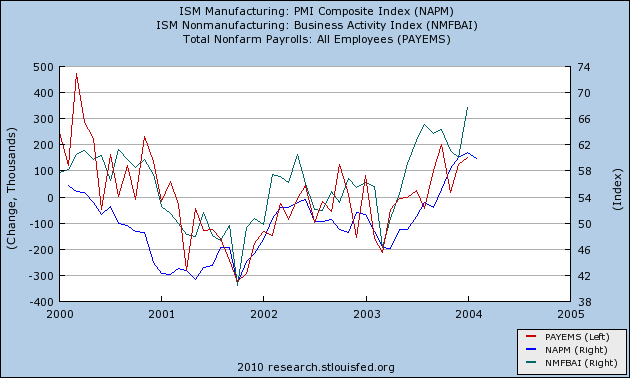
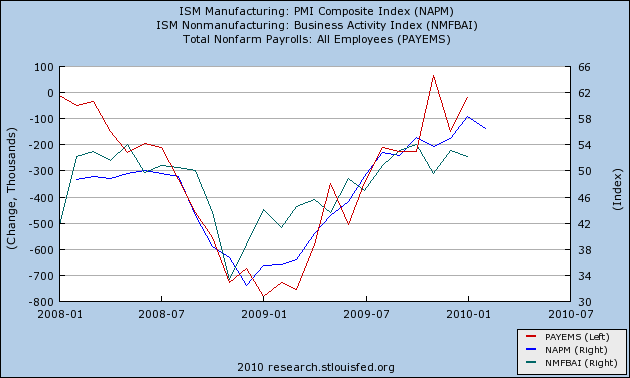



Nonfarm private employment decreased 20,000 from January to February 2010 on a seasonally adjusted basis, according to the ADP National Employment Report®. The estimated change of employment from December 2009 to January 2010 was revised down, from a decline of 22,000 to a decline of 60,000. The February employment decline was the smallest since employment began falling in February of 2008.
Two large blizzards smothered parts of the east coast during the reference period for the BLS establishment survey. The adverse weather had only a very small effect on today’s ADP Report due to the methodology used to construct it. However, the adverse weather is widely expected to depress the BLS estimate of the monthly change in employment for February, but boost it for March. Therefore, it would not be unreasonable to expect the BLS estimate for February (due out this Friday) to be less than today's ADP Report even though the BLS estimate will include the hiring of temporary Census workers not captured in the ADP Report.



The government decided at a cabinet meeting to move ahead with steep cuts in civil-service salaries and entitlements, and to raise Greece's sales tax by two percentage points.


"The manufacturing sector grew for the seventh consecutive month during February. While new orders and production were not as strong as they were in January, they still show significant month-over-month growth. Additionally, the Employment Index is very encouraging, as it is up 2.8 percentage points for the month to 56.1 percent. This is the third consecutive month of growth in the Employment Index. With these levels of activity, manufacturers are seemingly willing to hire where they have orders to support higher employment."
Personal income increased $11.4 billion, or 0.1 percent, and disposable personal income (DPI) decreased $47.6 billion, or 0.4 percent, in January, according to the Bureau of Economic Analysis. The decrease in DPI reflected an increase in federal nonwithheld income taxes. Personal consumption expenditures (PCE) increased $52.4 billion, or 0.5 percent. In December, personal income increased $41.2 billion, or 0.3 percent, DPI increased $40.3 billion, or 0.4 percent, and PCE increased $26.4 billion, or 0.3 percent, based on revised estimates.







unadjusted numbers vs. a year ago are the only valid way of looking at data. Same store sales, comparisons to projections, and non-seasonally adjusted comparisons to the previous month are all bogus comparisons.I agree that, if we can't gauge seasonality in the data to enable valid month-over-month comparisons, then we should at very least take a look on a month-by-month "unadjusted numbers vs. a year ago" to see whether the YoY comparisons are getting better or worse -- this is what Mish failed to do with either railroad data or the CS-CPI, and why both of those data series moved against him.
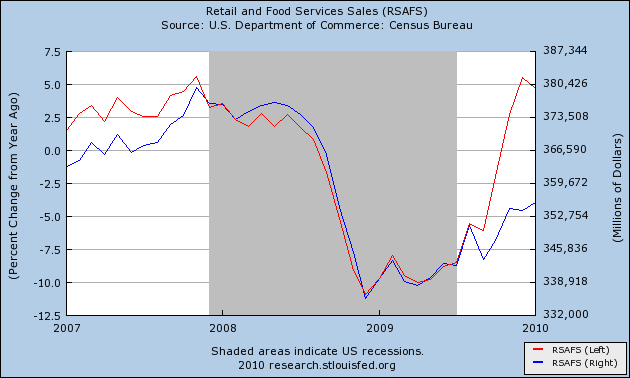
"note that only 13% of states are reporting growth which means that 87% of states have flat to declining sales. Amazingly the headline has a positive spin that revenues was up.Except that the article very specifically uses "unadjusted numbers vs. a year ago." exactly what Mish calls "the only valid way of looking at data." The article says:
Even then, close observers will note that revenues were up vs. projections. That does not mean they were up at all. That was very sloppy reporting, at best."
In November, no state registered sales tax revenue growth over the year, but by December 13 percent enjoyed growth.(my emphasis)
.... Those numbers could change quickly, it said. The states reporting year-on-year growth were concentrated in the Midwest, where the federal automobile industry bailout boosted manufacturing sales and inventories.
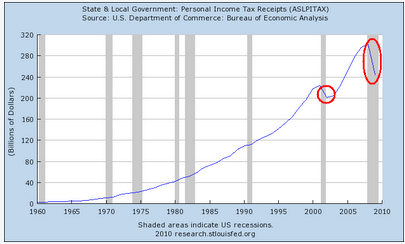
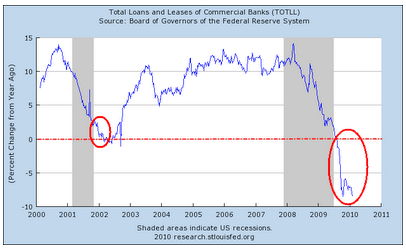
For the first time in many months, the total Tennessee tax collections were actually a bit above the level of the prior month a year agoMish actually highlights the fact that the receipts came in less than estimates -- again, not the method he himself accepts as being valid.
Taxes collected by the state Education Trust Fund continue to jump around from month to month, with tax collections in January dropping 17.5 percent, or $80.7 million, compared to January 2009, the state finance department reported Monday.Of course, the discussion isn't about corporate or estate taxes, it is about sales tax receipts, and had Mish moved his gaze ever so slightly to the left, he would have seen, clear as day in the accompanying chart, that sales tax receipts were UP 7.2% in January 2010 vs. January 2009.
That followed a gain of 13.5 percent in December compared to December 2008 and a drop of 6.7 percent in November compared to November 2008.
It was another tough month for Georgia revenue collections. Governor Sonny Perdue’s office says for the month of January, collections dipped 8.7 percent from the same month a year earlier. That now makes it 14 straight months of declining tax revenue.That's certainly looks bad, but again Mish fails to take account of the trend. Specifically, in December 2009, Georgia reported that
The Peach State pulled in $1.4 billion, compared with $1.49 billion in December 2008.Like Indiana and Tennessee, the Georgia statistics show continuing improvement, and a likelihood that the bottom on a monthly basis has already taken place.
The $1.4 billion last month included $347.4 million in sales tax revenue (down 20.2 percent),
"Births are added to the monthly survey in February, May, August, and November of each year. At the same time, deaths are removed from the survey. To minimize the effect of births and deaths on the month-to-month change estimates, we phase-in these changes by incrementally increasing the sampling weights of the births and decreasing the sampling weights of the deaths in a similar fashion. In the first month, we tabulate the births at one-third their sampling weight and tabulate the deaths at two-thirds their sampling weight. In the second month, we tabulate the births at two-thirds their sampling weight and tabulate the deaths at one-third their sampling weight. In the third month, we tabulate the births at their full sampling weight and the deaths are dropped (sampling weight equal zero)."And here is the reliability of the survey:
Estimation and sampling varianceIn other words, the Census Bureau tracks respondents for several months. If any go out of business, they get zeroed out. The statisticians aren't dunces. They account for exactly the issue Mish complains about, except he wasn't inquiring enough to check their actual procedures.
Advance sales estimates for the most detailed industries are computed using a type of ratio estimator known as the link-relative estimator. For each detailed industry, we compute a ratio of current-to-previous month weighted sales using data from units for which we have obtained usable responses for both the current and previous month. The For each detailed industry, the advance total sales estimates for the current month is computed by multiplying this ratio by the preliminary sales estimate for the previous month (derived from the larger MRTS) at the appropriate industry level. Total estimates for broader industries are computed as the sum of the detailed industry estimates.





Laughing at those who said the GDP would be revised downward is a legitimate thing to do. But only if you were to give us some details about this upward revision, as you have done in the past when GDP is released. Why not explain how the analysts are wrong who are saying that this GDP upward revision is indicative of a worse situation for actual growth than the lower GDP number announced last month?









Motor vehicle output added 0.44 percentage point to the fourth-quarter change in real GDP after adding 1.45 percentage points to the third-quarter change. Final sales of computers subtracted 0.01 percentage point from the fourth-quarter change in real GDP after subtracting 0.08 percentage point from the third-quarter change.
Real personal consumption expenditures increased 1.7 percent in the fourth quarter, compared with an increase of 2.8 percent in the third. Real nonresidential fixed investment increased 6.5 percent, in contrast to a decrease of 5.9 percent. Nonresidential structures decreased 13.9 percent, compared with a decrease of 18.4 percent. Equipment and software increased 18.2 percent, compared with an increase of 1.5 percent. Real residential fixed investment increased 5.0 percent, compared with an increase of 18.9 percent.
Real exports of goods and services increased 22.4 percent in the fourth quarter, compared with an increase of 17.8 percent in the third. Real imports of goods and services increased 15.3 percent, compared with an increase of 21.3 percent.

